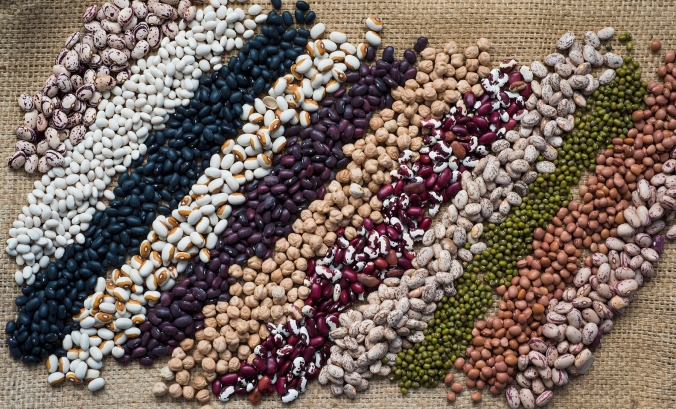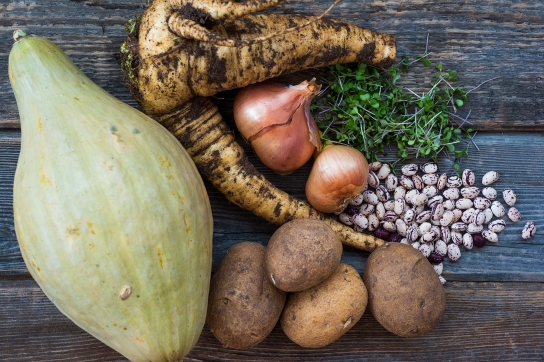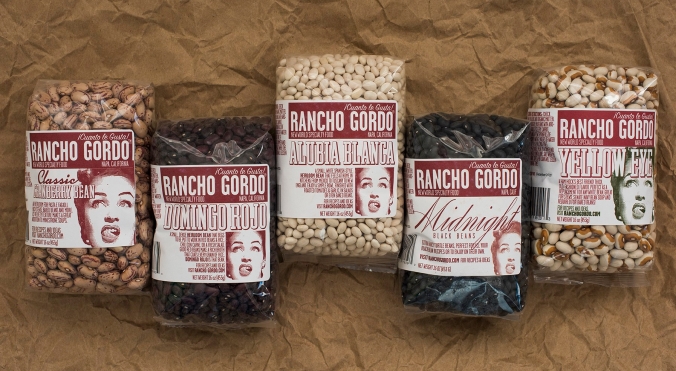My love for beans knows no bounds. They’re cheap, filling, easily available, simple to cook, packed with nutrition and utterly delicious. Seriously, what more could you want? There’s a good reason rice and beans are the staple food for well more than half the world’s population.
I’m on a personal mission to encourage people to cook dried beans, rather than canned. Look, I’m a big fan of having a well-stocked pantry, and if storing a couple of cans of black beans or chickpeas in yours means you’re more likely to whip up a quick soup or homemade hummus, then I’m all for it. But for sheer value and flavor, you can’t beat dried beans. They’re way cheaper, they’re not difficult to cook and they really don’t take more time – you just need to plan in advance. There are a lot of fairly strong opinions on how to cook dried beans, so if you already have a way that works well for your household, keep it. I’m here to tell you how I do it and why, but ultimately it doesn’t matter to me how you prepare your dried beans, just that you do.

Apparently we have quite a few different dried beans in our pantry.
Spoiler alert (and controversial bean-cooking tip alert, too): I cook all of my beans the exact same way, in a slow cooker (also commonly known as a Crock-Pot). And I no longer soak the beans in advance. Plus, I salt them at the beginning. That’s right, friends: I don’t soak my beans. And I salt before they’ve started cooking. I have spent years and years cooking dried beans, and I’ve tried every method: simmering on the stove, pressure cooker and on and on, and I’m personally convinced that the slow cooker, with its incredibly gentle simmer and moist, low-heat environment, is perfect for beans. And I get to skip the soaking step, too. (I don’t have an InstaPot, and I’m not going to buy one, but if you have it and you like it, then use it for beans.)

We received heirloom borlotti beans in our CSA this fall!
I generally start my beans the night before, so that I can either make them into a spread, like hummus, the following day, or so I can incorporate them into another recipe, like chili. But if you want a warm pot of beans for dinner, the same principle applies: put your beans in the slow cooker, cover with three to four times the quantity of water, salt generously, add aromatics like carrots, onions, rosemary, bay or garlic, if appropriate, and cook on low for six to eight hours. Obviously, there’s a lot of variability here; the actual time it takes will depend on your individual slow cooker and how many beans you’re cooking. And if I’m using the beans in a pureed dip or a creamy, rich soup, I want them super-soft, but if they’ll go in a grain salad or a pasta, I’m looking for a bit more body and texture, so I won’t cook them as long. Taste, always taste, and soon you’ll figure out what works for you.
An old wives’ tale used to claim that salting beans in advance made them tough. This is an unfortunate bit of misinformation, because it assumed that all of the beans you were cooking were at least a few years old, and yes, salting those does make them tough. But if your beans are reasonably fresh, then salting as they cook allows the seasoning to permeate the beans and offers much deeper layers of flavor. Just remember to taste the beans before you add any additional salt or use them in a recipe with other salty ingredients, so you can adjust accordingly. If you’re incorporating tomatoes or other acidic ingredients, do wait to add these until the beans are fully cooked.

From left: the same white bean raw, soaked and cooked.
If you’re not using a slow cooker, which sort of soaks and cooks the beans at the same time as it slowly comes up to temperature, you will want to soak your beans in advance. Using boiling water to soak your beans speeds up the needed time; use room temperature tap water if soaking overnight. Soaking pre-hydrates the beans, allowing them to cook faster; some claim that it also makes them more digestible. I firmly believe that eating beans regularly is the best way to allow your body to adjust to any potentially unpleasant side effects.
A few other tips for cooking with dried beans: make sure you sort and rinse all dried beans before cooking (or, as our North Carolinian friend Kelly says, “you’ve got to look your beans”). Dried beans often contain small stones, pebbles or other debris, and take it from me: when you make a pot of gorgeous heirloom Anasazi beans for a group of forty people at a prestigious seed school, you do not want to learn too late that you should have sorted those beans. Save yourself and your guests unexpected dental work: spread the beans out on a baking sheet and sort through them, or make children do this (then review their efforts yourself). Give them a good rinse, too; beans collect dust as they sit, especially in bulk bins, and the dirt won’t harm you but there’s no need to eat it.

My idea of a perfect supper.
If you’re using more than one kind of bean, and if one of those kinds are black or kidney beans, cook them separately so they don’t color all of the paler beans an unappetizing grey. And know that not all beans will cook evenly together, so you’ll want to taste each type to ensure they’re all cooked. There are few things sadder than hard, chewy, indigestible, undercooked beans.
Once you’ve made your tasty, nourishing pot of beans, just eat as is with a drizzle of olive oil and some fresh black pepper on top. Incorporate into a soup, stew, or chili. Keep a container in the fridge and add to salads and wraps throughout the week. Make healthy dips for raw vegetables. Beans can be a great addition to just about any meal, especially if you’re focused on eating less meat. Beans are packed with fiber and protein and in the case of the darker beans, tons of anthocyanins and other antioxidants. These really do count as a superfood.
And don’t throw out the bean cooking liquid! Even if you’re not making a soup, save and freeze that “bean stock” and use for future soup bases, or use to thin pasta sauces or pureed dips. There is a ton of flavor (and nutrition) in there, and when you cook dried beans you get that stock as an added bonus. (If using canned beans, do throw out the liquid they come in. Too much salt. Weird flavor. Odd consistency. Strange additives.)

Homemade hummus is simple, fresh, healthy and delicious. And also cheap.
And where should you buy your dried beans? I’m a big fan of bulk departments, and your favorite grocery may have a good selection of beans. They may also carry bagged dried beans, but be aware that these have often sat on the shelf for quite some time; even though the beans are dried and can technically last for years, you want to buy them as close to harvest as possible, both for flavor and so they cook more quickly. (If you’ve ever simmered a pot of beans for a decade or more and they never softened, it’s because the beans were old.) Buy beans from a place that’s moving through their inventory quickly, i.e. in a community where people actually cook. I get local pinto beans from a farm here in Delta; Colorado pintos are pretty easy to find in the Denver area. I try to buy from Latin American markets whenever possible, as the beans are usually fresher.

So many beans! And their lovely poetic names!
There are a lot more types of beans in the world than the standard black, navy, pinto and kidney that we typically encounter. If you want to get into serious mail-order bean buying, and you want incredible selection, esoteric varieties and a sharp, brilliant staff, I cannot recommend Rancho Gordo highly enough. (Not sponsored in any way; we just really respect this man and his company.) Rancho Gordo, led by the visionary Steve Sando, is essentially singlehandedly responsible for reintroducing many forgotten heirloom beans to the market. Steve and his team are passionate about teaching people how to cook with these indigenous beans, and many of the specialty varieties they offer can’t be found anywhere else. Plus, if you’re a gardener, remember that planting a few heirloom beans this year will allow you to start your own bean operation!
“All of my agricultural pursuits have been based on being someone who likes to cook but gets frustrated by the lack of ingredients, especially those that are native to the New World. One of the things that originally drew me to beans was the fact that they are indigenous to the Americas. It seems to me these indigenous ingredients should be familiar, if not common. American cuisine is re-inventing itself and I’d love to include ingredients, traditions and recipes from north and south of the border as part of the equation. I love the concept of ‘The Americas.’ I feel as if it’s just as important as the European heritage many of us share.
As you cook these heirloom beans and other grains and ingredients, keep in mind that we have a common New World culture with Mexico and the rest of the Americas. What you are doing isn’t exotic and esoteric. It’s continuing traditions that are well-established for a reason. I think most of us who are immigrants to the Americas are staying, so rather than constantly trying to reproduce English gardens or European wine, it’s nice to know what’s from here and discover ways of incorporating these ingredients into your kitchen. New World food is exciting, tasty, healthy, romantic, and possibly, easier on the earth.”
-Steve Sando, Rancho Gordo
How can you not love this guy and his passion for beans? Now get a pot going so you have beans for dinner (and lunch, and breakfast) this week!
Thank you, thank you, thank you, Elizabeth, for alerting us to Rancho Gordo! I’ve just now subscribed.
Slowly, and only in my retirement, I am becoming a cook — mainly to manage health issues as naturally as possible. Your former sessions on the Front Range + your current posts are helping big time to define the kind of cook I want to be.
(btw: Broomfield is too far for me to manage — looking forward to possible future workshops closer to Lakewood)
LikeLike
Karen, what a lovely comment. Thank you so much for your kind words, and I wish you all success in your cooking!
LikeLike
Thanks for the wonderful article and link to the Rancho Gordo site. Here is another of my favorites I discovered when living in Tucson. I was delighted to see the Gordo products on their website. It’s the Native Seeds/Search website: https://shop.nativeseeds.org
Thanks Elizabeth – miss TA’ing for you, but delighted with your success at getting Quiet Farm going.
LikeLike
Hi Deb! Thanks for your comment; Native Seeds/Search is a terrific organization. I miss teaching and having your help, too. I hope you’re living comfortably in your tiny house somewhere beautiful!
LikeLike
One of my “Family Goals” (there’s only 2 of us) this year is to eat less red meat so the idea of beans & rice (or quinoa, mixed ancient grains, etc) sounds wonderful. The combination makes nearly a whole protein so not bad! The place where I buy my Colorado ‘grown’ honey has started to sell different dried beans as well. Convenient! Thanks for all of your good ideas and suggestions!!!
LikeLike
Hi Susan! Eating less (or no) meat is definitely one of the very best choices you can make for your own health and the planet’s; beans and other grains are a terrific healthy addition to your diet. Thanks for reading the blog!
LikeLike
Thank you for all the cooking tips as I just recently started using dried beans. A few questions though: do I still need to sort and rinse bagged beans or is that already done with bagged beans? I usually use my slow cooker as well for beans but recently I forgot to soak and did not have enough time to slow cook them either (I know, lack of planning) nor did I have any canned beans. So I read that you could boil them for 3 min and then I used my pressure cooker. They came out weird. Almost a smoky flavor but not in a good way. Do you think that was the cooking method or possibly the actual beans?
LikeLike
Hi Sara! I still sort and rinse any dried beans, whether they came in bulk or pre-bagged. It doesn’t take long, and it’s worth the effort. As for the pressure cooker, it’s tough to say. I haven’t cooked beans in a pressure cooker but I wouldn’t expect them to taste smoky and strange. Maybe try again with a different type of bean to see if you get the same result? Good luck!
LikeLike
Pingback: An ode to kale | Finding Quiet Farm
Pingback: How to make hummus | Finding Quiet Farm
Pingback: Let’s make hot sauce! | Finding Quiet Farm
Pingback: Farm update: November 9 | Finding Quiet Farm
Pingback: A season of rest | Finding Quiet Farm
Pingback: Fight inflation in the kitchen | Finding Quiet Farm
Pingback: The bean harvest | Finding Quiet Farm